Wolf spiders can be scary-looking spiders, though they are not aggressive towards humans. There are numerous wolf spiders in North America and many can be encountered in Texas.
If you are wondering what wolf spider you saw in your home or yard, continue reading to find out more.
Table of Contents
What Are Wolf Spiders?
Wolf spiders belong to the Lycosidae family, taken from ancient Greek, which means wolf. They are agile and robust hunters with excellent eyesight. They hunt alone, living mostly in solitude and they do not spin webs.
They are an excellent and opportunistic hunter that will pounce on prey, some will chase prey over short distances and others wait for prey to pass them, close to their burrow.
Wolf spiders resemble a nursery web spider, but they carry their egg sacs attached to their spinnerets, while the nursery web spider carries the egg sac in their mouth. The wolf spider also has two large eyes out of the eight eyes, which helps you distinguish them from nursery web spiders.
Unlike many other spiders, the wolf spider does not spin a web and rely on its webs to ensnare its prey, they hunt and stalk their prey.
How to Identify a Wolf Spider
There are some things you can take into consideration to help you identify a wolf spider; these include:
- Look at the physical features. They are hairy, brown to gray with lines on their cephalothorax and abdomens.
- Take note of their eyes. They have eight eyes in three rows. The first is four small eyes, the second is two large eyes and the third is two medium eyes. The eyes in the center of the face are the largest with reflective tissue, which you can see if you shine a light at the spider.
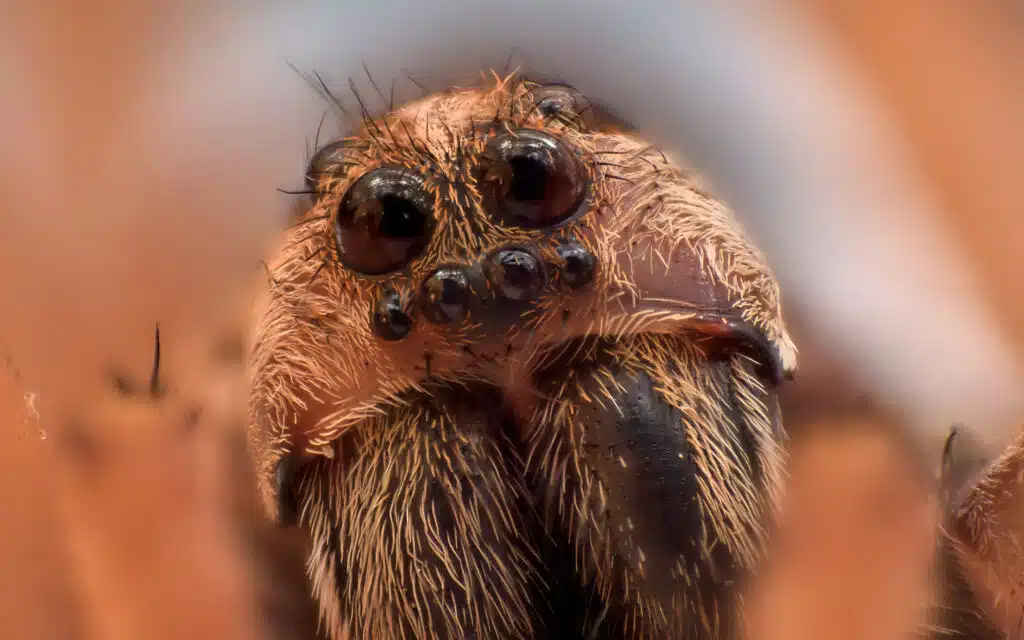
- They have three claws at the end of each leg. They help the spider run and climb.
- Their fangs look like pincers with a side-to-side orientation, which is unique to wolf spiders
- It’s common to confuse a wolf spider and brown recluse, but a wolf spider does not have a violin marking on the cephalothorax. They also have shorter legs than the brown recluse.
- They have a hairy abdomen, which is why they are often confused with tarantulas, the wolf spider is considerably smaller than a tarantula.
Types of Wolf Spiders in Texas
There are many species of wolf spider living in Texas, the most common species include:
1. Tigrosa annexa
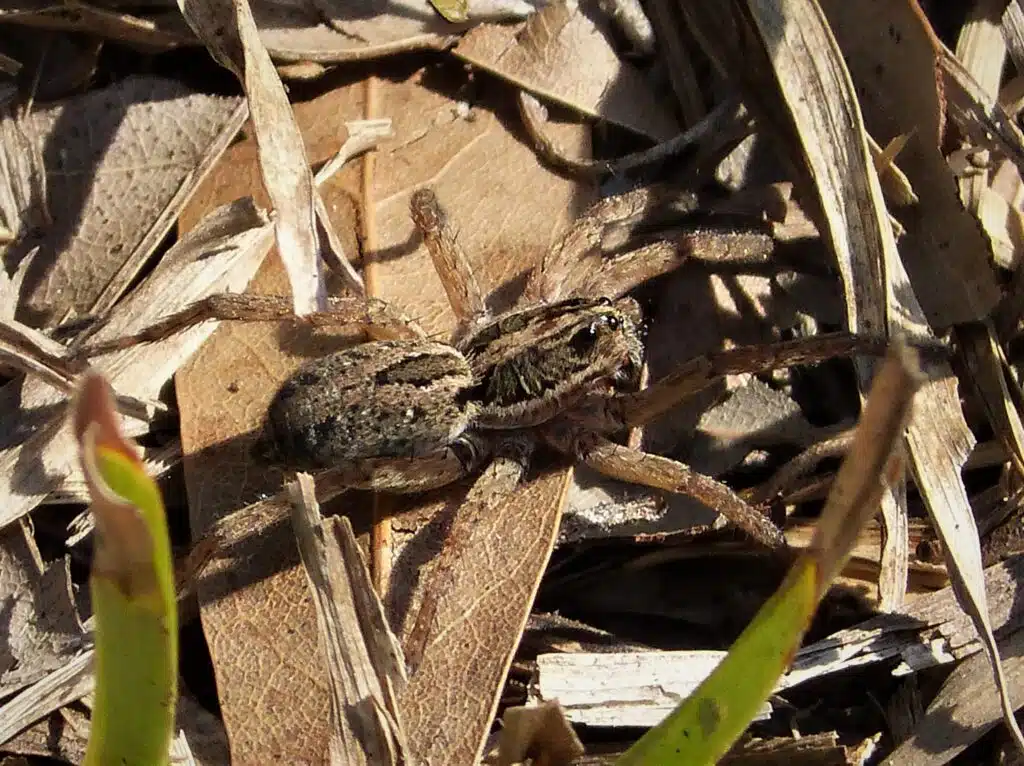
The Tigrosa annexa can grow to 18mm in body length and is considered the smallest of the species. Females are light yellow with a V shape on the sternum, males are pale in color with no pattern. The carapace has two yellow dashes with a median stripe on the cephalothorax.
This wolf spider prefers a sandy habitat, which is dry.
2. Rabid Wolf Spider
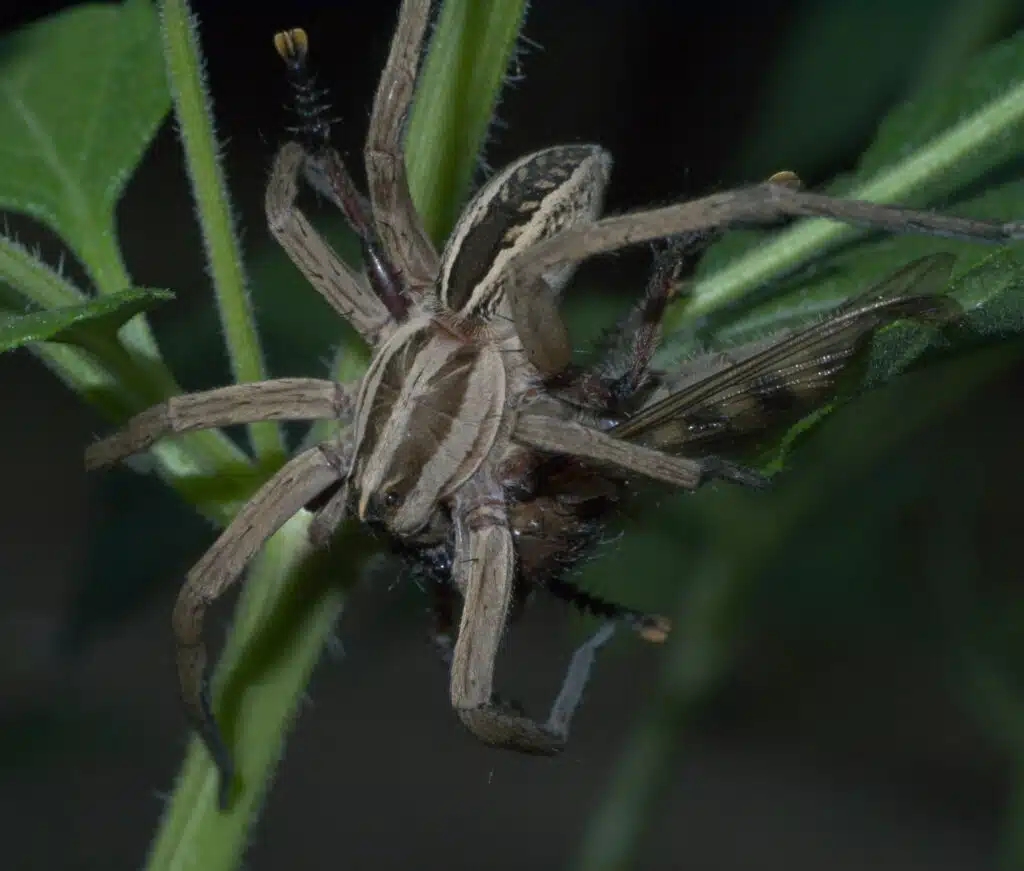
Rabid wolf spiders (Rabidosa rabida) got their name from their fast and erratic movements. They do not carry the Rabies virus and are harmless to humans. They are aggressive and may challenge you if they feel threatened.
They will bite if they are provoked, though they prefer to run away. Bites are painful, but not medically significant.
This spider is light brown in color and has two thick dark brown stripes that run down either side of the head. The abdomen also has a dark line with two thin brown lines on either side and a tan body. Their eyes reflect in the light.
They are active hunters and do not spin webs. They are known to wander indoors searching for food.
3. Tigrosa georgicola
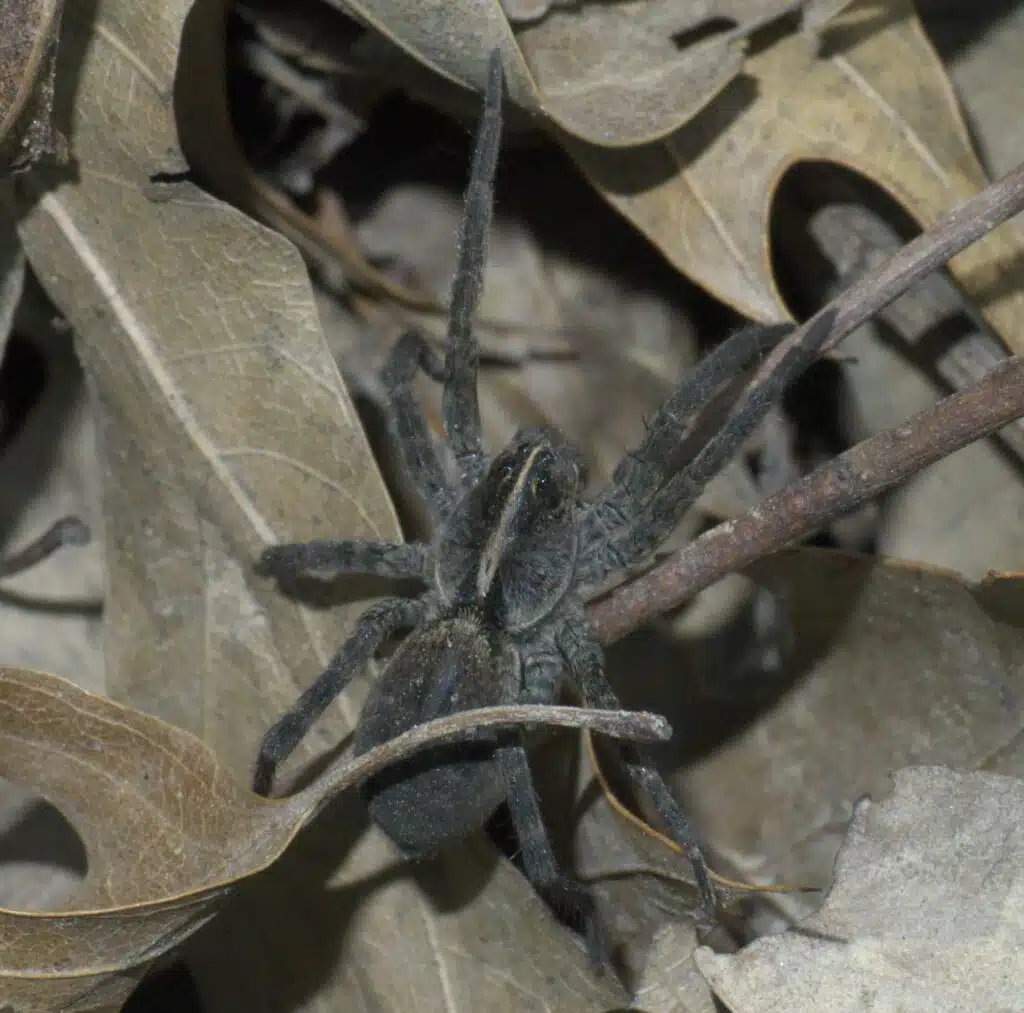
This is one of the largest wolf spiders you will find in Texas, which hunts for prey. They are fast movers, concealing themselves in dark corners and under logs and leaf litter.
They are dark brown with a light tan stripe down the center of the carapace. They have some faint pale markings on the abdomen their legs have banding at the joints. They also have reflective eyes, which can be seen if you shine a flashlight at the spider.
These are daytime hunters, which is why they are commonly encountered in Texas. They will bite if they feel threatened, though their venom is not considered medically significant in humans, the bite will take a few days to heal and can be painful.
4. Carolina Wolf Spider
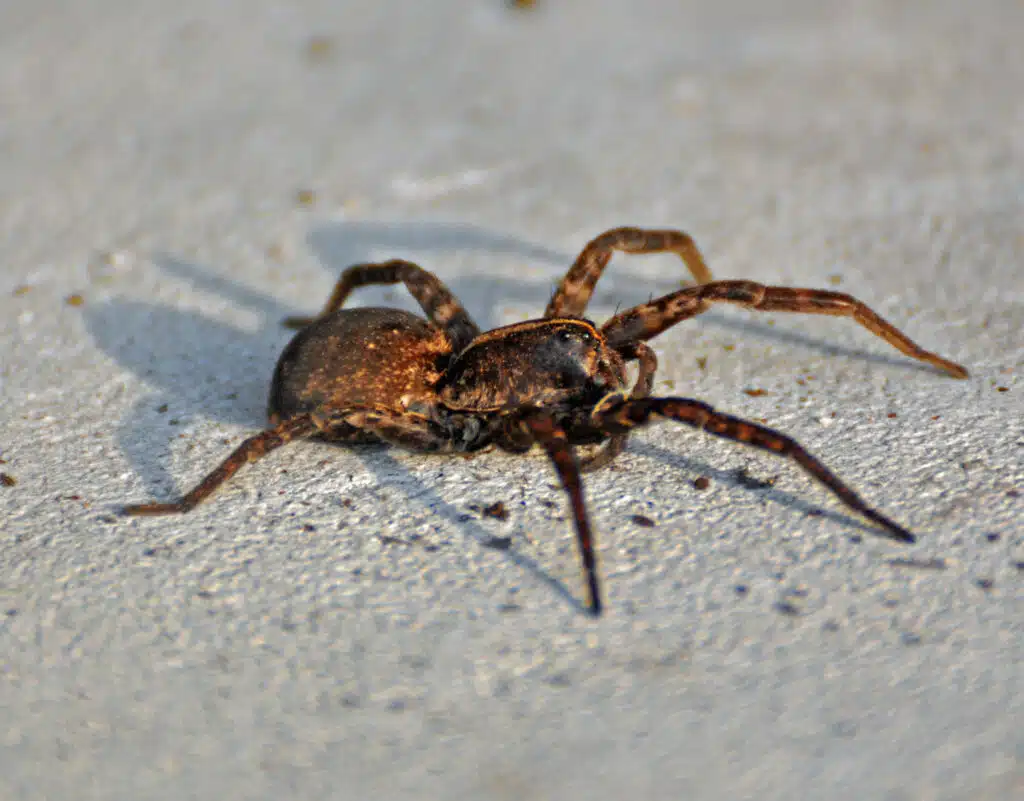
Carolina wolf spiders (Hogna carolinensis) are excellent hunters. They hunt at night, though they are sometimes encountered during the day.
They are brown and black, which helps them camouflage in the forest. They are known to wander indoors hunting for food.
The Carolina wolf spider is fast hairy and large with an elevated head. The cephalothorax has a central tan line with dark brown or black on the sides with a light border on the edges. They have an almond-shaped abdomen with a dark almond-shaped marking near the waist. A chevron pattern can be seen close to the rear.
Females are larger and darker than males. After mating, the female carries her egg sac with her on her back until the spiderlings hatch. You may see the female carry all the spiderlings on her abdomen until they are ready to fend for themselves.
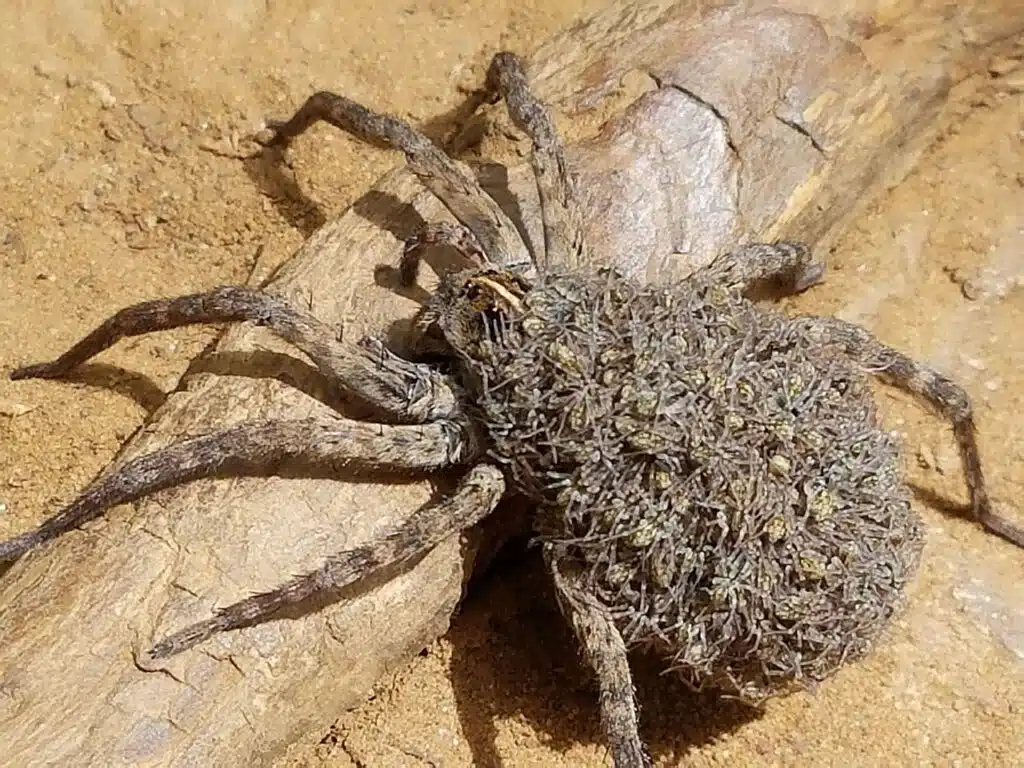
5. Field Wolf Spider
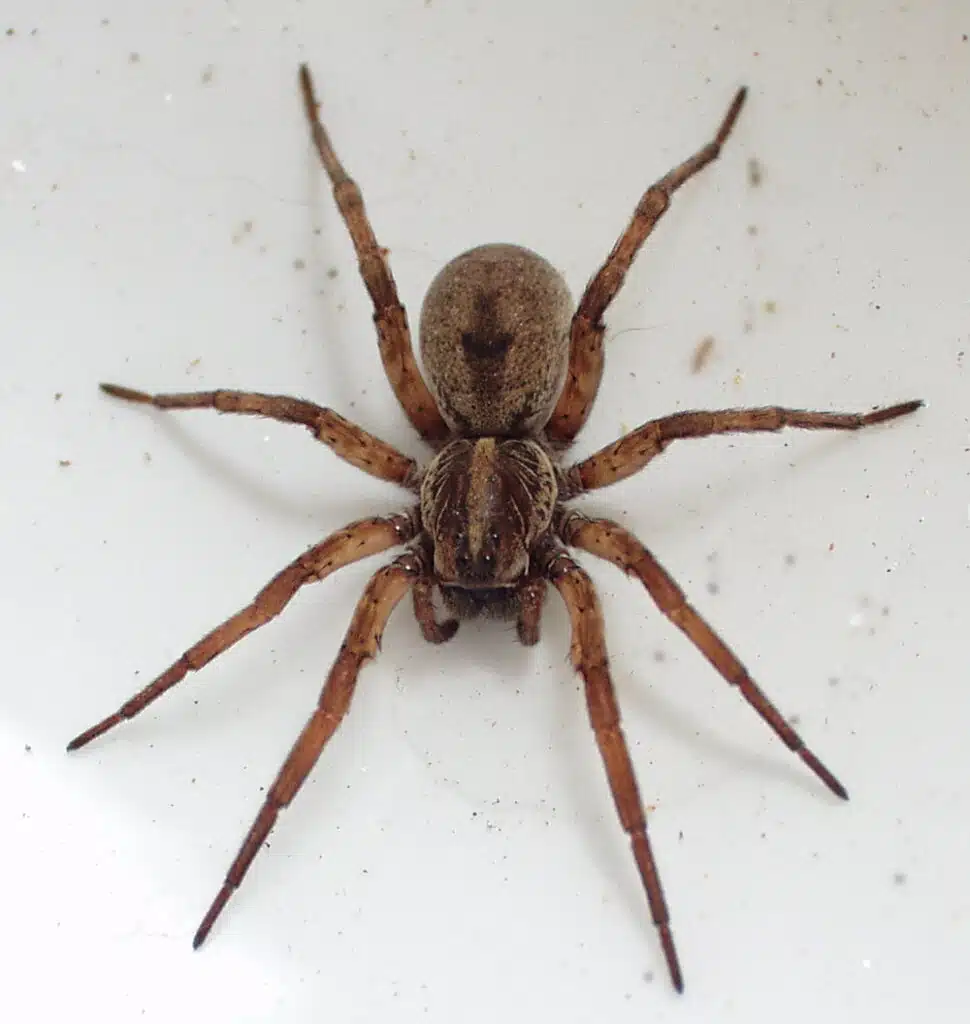
Field wolf spiders (Hogna lenta) are ground spiders that make burrows in the dirt. They eat beetles and insects with spiderlings eating fruit flies. Their burrow comprises tripwires, which the spider feels when something walks over their burrow.
They stalk the prey, pouncing on it and injecting their venom through the fangs, which paralyzes the insect. Their venom is not dangerous to a healthy human and is no worse than a bee sting.
They will raise their front legs in the air if they feel threatened, making themselves look bigger than they are. If this doesn’t work, they will lunge at their attacker.
This wolf spider prefers living in forests and dense shrubs, where they build burrows. They are not common visitors in homes, though they will wander into tents if there are mosquitoes.
6. Shoreline Wolf Spider
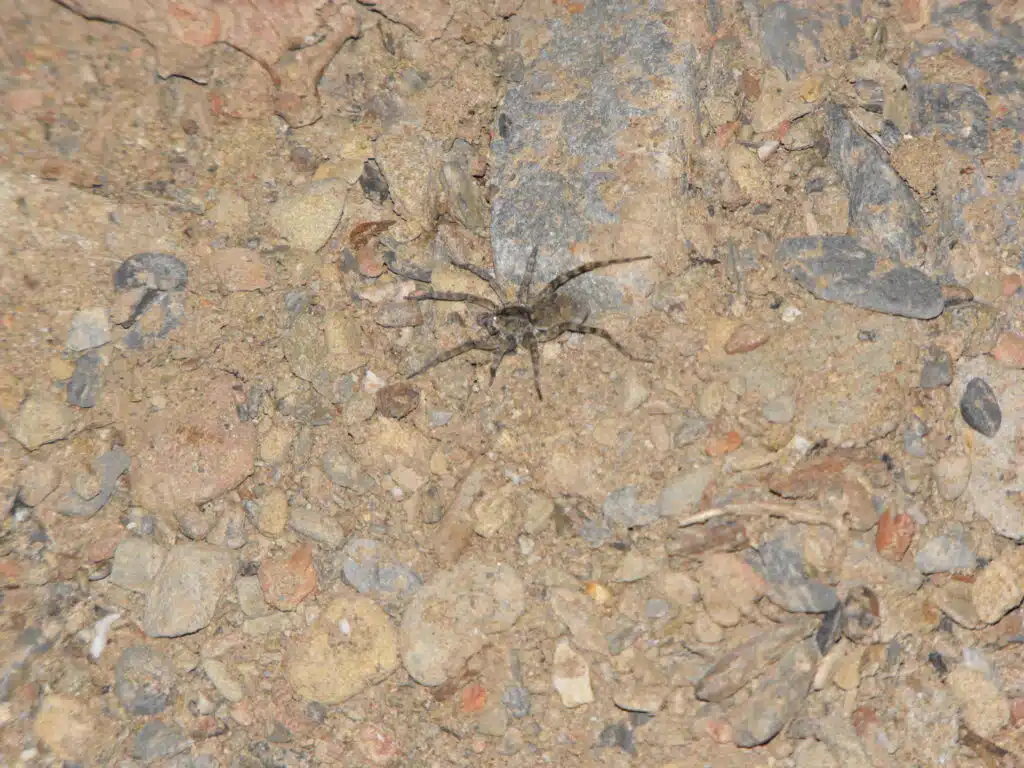
The shoreline wolf spider (Arctosa littoralis) is also known as the beach wolf spider and is usually found at the beach, though they can live just about anywhere.
They are experts at camouflage and will hide in sand or under driftwood during the day. The shoreline wolf spider is exceptionally fast for its size. They can grow to 15mm in body length.
Their bites are painful, but the spider is not aggressive and will only bite if they are provoked. Their bites are not considered a medical emergency.
7. Wetland Giant Wolf Spider
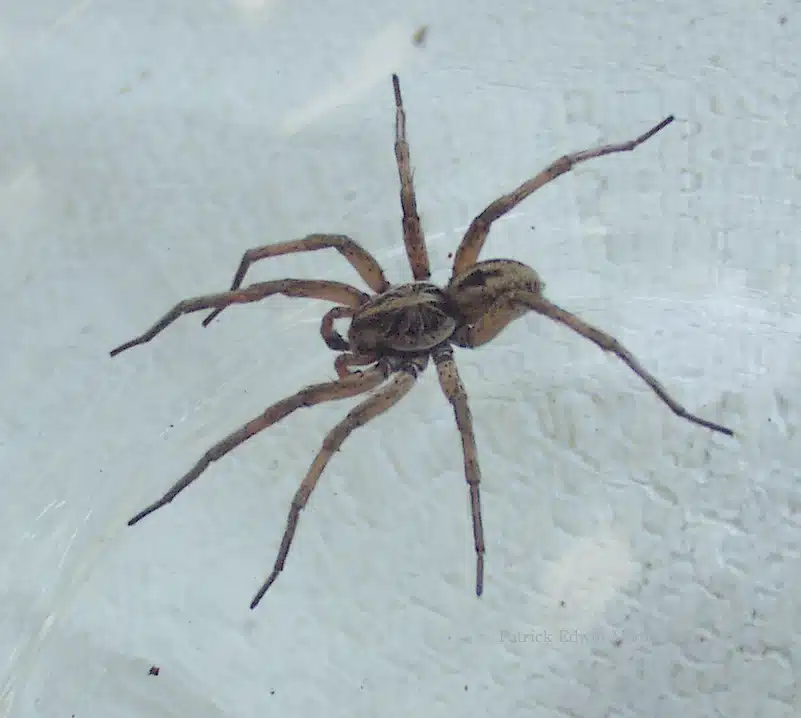
A female wetland giant wolf spider (Tigrosa helluo) can grow to 31mm in boy length with males growing to 24mm in boy length. They are smaller than some of the other wolf spider species.
They have a brown carapace with a distinct yellow stripe that extends from the cephalothorax. They have black spots under their abdomen. The legs are different between the male and female with males having yellow legs with no markings and females having red/brown legs with banding.
8. Santa Rosa Wolf Spider
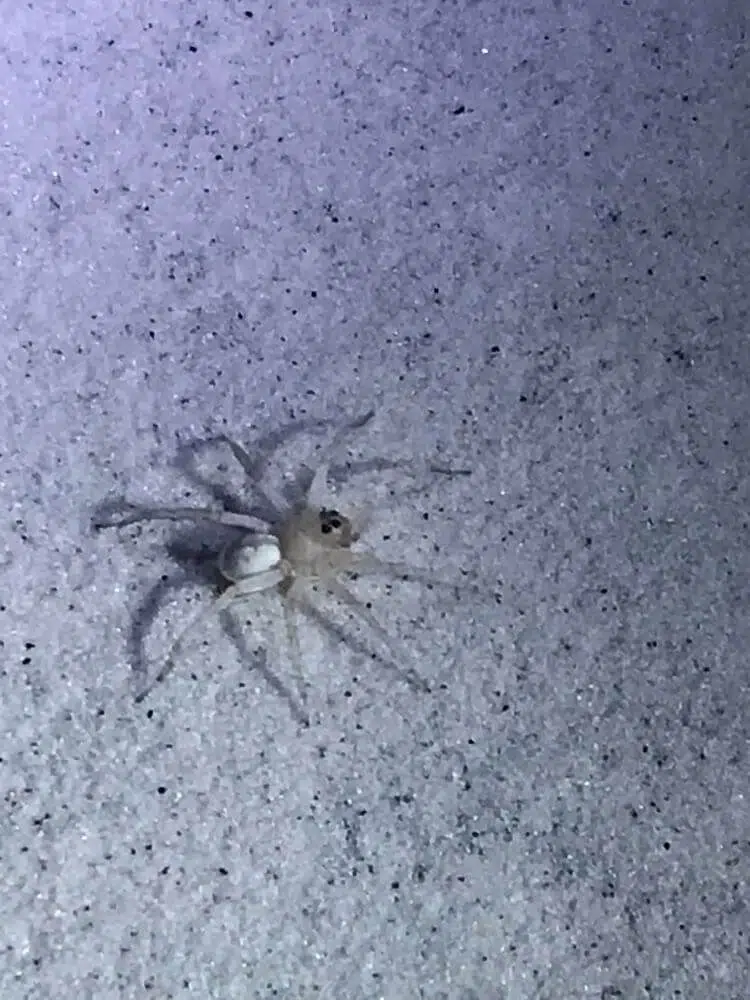
The Santa Rosa wolf spider (Arctosa sanctaerosae) is light orange to white and is often encountered on dunes where there is loose and shifting. They are mostly seen during fall to spring.
These are fast spiders that are excellent hunters with brilliant eyesight. They stalk and pounce o their prey, biting them and releasing venom which paralyzes the prey.
They are not inclined to bite humans, but they will bite if they feel provoked.
Are Wolf Spiders in Texas Venomous?
Wolf spiders look very scary but are not considered dangerous to humans. They will bite and should not be handled.
A bite from a wolf spider looks the same as a bug bite. You may see a small red itchy bump that is slightly swollen and goes away after a few days. Unless you see the spider that bit you, it’s difficult to identify what really bit you.
Some people do have an allergic reaction to the venom. You should seek immediate medical attention if you experience a red line that runs from the bite, the bump increases in size, you experience facial swelling or breathing problems or you experience dizziness.
Treating a wolf spider bite is the same as any insect bite. Wash the bite site with warm soap and water to reduce the risk of infection. Place a bandage over the bite site, which helps reduce the risk of infection.
If the bite starts to itch and become uncomfortable, take an antihistamine to manage the discomfort.
Where To Find Wolf Spider in Texas?
Wolf spiders can be found throughout the United States, including Texas. They can be found throughout the state and are constant movers, due to their hunting behaviors, as a result, they are the most commonly encountered spiders in Texas.
Hundreds of wolf spiders can live in a single yard in Texas.
When To Find Wolf Spiders in Texas?
Wolf spiders are most commonly encountered as summer turns to fall. The drop in temperature results in the spiders looking for shelter and mates, which leads them to find cracks and holes in homes.
What To Do If You See a Wolf Spider in Texas?
If you are wondering what the chances are that you will encounter a wolf spider in Texas, then you should know that you are never more than five feet from a spider at any time.
The best method is to carefully cover the spider with a glass jar or container and use a piece of paper, sliding the paper under the jar to trap the spider. Turn the jar or container over, keeping the paper in place to keep the spider trapped, you can then release it outdoors.
Note that most people’s first instinct in seeing a larger spider is to squash it, either with your foot or the nearest object. Though this is not recommended. Females carry their babies with them, which means squashing the spider can make matters worse, as you can release hundreds of spiders into your home.
How To Prevent Texas Wolf Spiders in Your House
The good news is that there are several things you can do to prevent wolf spiders from getting into your Texas home, these include:
- Maintain your landscaping and lawn
- Trim back bushes and tree branches a minimum of five feet from the outside of the home
- Fill in any gaps, cracks, and holes in your home’s exterior
- Repair your screens for windows and doors
- Add door sweeps under your exterior doors
- Check the weatherproof to ensure it is free of any damage
- Dust and vacuum weekly, focusing on dark corners
- Add tight-fitting lids to your trash cans
- Feed pets inside, removing bowls once they have finished
- Do not use outside lights, as these attract insects, which can attract a hungry wolf spider
You can use natural essential oils to control wolf spiders in the home. Spiders are repelled by certain essential oils, including cinnamon, peppermint, cedar, citrus, and tea tree.
Repellent Spray
- 5 to 10 drops of peppermint oil
- ¼ teaspoon dish soap
- 12 ounces of distilled water
- Spray bottle
- Mix ingredients in the bottle
- Spray the wolf spider’s hideout weekly until the spider moves elsewhere.
Boric Acid
Another option is to use boric acid, an abrasive powder, which creates puncture wounds in the spider’s exoskeleton, which causes them to leak bodily fluids. This causes dehydration and death.
Even though it sounds horrid, it is an effective way to get rid of wolf spiders in the home, if you are too scared to use the catch and release method.
Boric acid is not recommended if you have pets and children in the home. You can sprinkle boric acid where you have found wolf spiders hiding.
Repellent Plants
Another natural way to get rid of wolf spiders is to grow repelling plants in your yard and close to the entrances of your home. Spiders do not like lavender, the gentle scent is relaxing for you and very unwelcome to spiders, mosquitoes, and fleas.
Eucalyptus is another repellent plant that spiders do not like, along with lemongrass, which is used to produce citronella oil. Peppermint can be grown in window boxes and outside the home and is a sturdy plant.
Keeping spiders away from the home can be done using the right techniques, such as regular cleaning, moving woodpiles from the home, using essential oils, and repellent plants.
Summary
While wolf spiders look scary with their large and hairy bodies, their fast speed, and their large eyes, they are harmless to humans and are non-aggressive.
Most people get rid of them by simply brushing them out of the home if they are found, as most wolf spiders are simply searching for food or a mate and make their way into the home by mistake. Do not provoke the spider, as they will bite as a last resort, which can be painful.